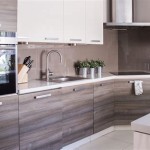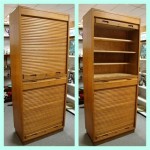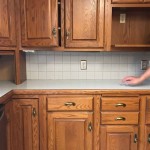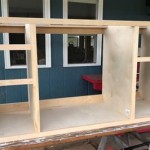Stainless Steel Kitchen Example: Design, Benefits, and Considerations
Stainless steel kitchens have gained significant popularity in both residential and commercial settings. Its enduring appeal stems from a combination of aesthetic features, practical advantages, and versatility in design. This article will explore the various facets of stainless steel kitchens, examining its design elements, the benefits it offers, and key considerations when planning such a space.
The term "stainless steel kitchen" can encompass a variety of design implementations. It may refer to a kitchen where all major appliances and work surfaces are constructed from stainless steel. Alternatively, it could describe a more nuanced application where stainless steel elements are integrated into a kitchen design, complementing other materials such as wood, stone, or glass. The choice depends on the desired aesthetic, budget constraints, and functional requirements.
The visual impact of a stainless steel kitchen is often characterized by its sleek, modern, and minimalist appearance. The reflective surface of the steel can create a sense of spaciousness and light, particularly in smaller kitchens. This is further enhanced by the inherent neutrality of the material, which allows it to blend seamlessly with a wide array of color schemes and design styles.
In commercial kitchens, stainless steel is the industry standard. This prevalence has influenced residential design trends, leading homeowners to seek the professional-grade look and durability that stainless steel offers. The material's association with cleanliness and hygiene further adds to its appeal.
Durability and Longevity
One of the primary advantages of stainless steel in kitchen design is its exceptional durability. Stainless steel is resistant to corrosion, rust, and staining, making it well-suited for the demands of a kitchen environment. Unlike materials like wood or laminate, stainless steel is not susceptible to water damage or warping. This inherent resistance contributes to its longevity, ensuring that a stainless steel kitchen can withstand years of use with minimal maintenance.
Furthermore, stainless steel is resistant to heat, making it ideal for use in proximity to cooktops and ovens. Hot pots and pans can be placed directly on stainless steel surfaces without causing damage or discoloration. This heat resistance also extends to its structural integrity, preventing warping or deformation under high temperatures.
The scratch resistance of stainless steel is another factor contributing to its durability. While stainless steel can be scratched, these scratches tend to be superficial and can often be minimized or removed with specialized cleaning products. The inherent strength of the material also protects it from dents and other forms of physical damage. Unlike softer materials like wood or plastic, stainless steel can withstand significant impacts without compromising its integrity.
The longevity of stainless steel translates into a long-term cost-effectiveness. While the initial investment may be higher than that of other materials, the reduced need for repairs and replacements over time makes it a financially sound choice. The increased resale value of a home with a stainless steel kitchen is also worth considering.
Hygiene and Ease of Cleaning
Stainless steel's non-porous surface is a significant advantage in terms of hygiene. Unlike porous materials like wood or granite, stainless steel does not absorb liquids or harbor bacteria. This makes it easier to clean and sanitize, reducing the risk of foodborne illnesses. Spills and splatters can be wiped away quickly and easily, preventing the growth of mold, mildew, and other harmful microorganisms.
The smooth, seamless surface of stainless steel also minimizes the number of nooks and crannies where dirt and grime can accumulate. This simplifies the cleaning process and ensures that all surfaces can be thoroughly sanitized. The absence of seams and joints also prevents the infiltration of liquids and debris, further enhancing its hygienic properties.
Maintaining a stainless steel kitchen is relatively straightforward. Regular cleaning with mild soap and water is typically sufficient to remove most stains and spills. For more stubborn stains, specialized stainless steel cleaners can be used. It is important to avoid using abrasive cleaners, as these can scratch the surface of the steel. Regular polishing can help to maintain the shine and luster of the stainless steel.
The ease of cleaning and sanitizing stainless steel makes it an ideal choice for individuals with allergies or sensitivities to certain cleaning products. Harsh chemicals are not typically required to maintain a hygienic stainless steel kitchen, reducing the risk of allergic reactions or respiratory irritation. This is particularly important in households with children or pets.
Design Flexibility and Integration
Despite its industrial aesthetic, stainless steel can be surprisingly versatile in terms of design integration. It can be combined with a wide range of materials, colors, and textures to create a variety of different looks. Stainless steel appliances and countertops can be paired with wooden cabinets for a warm and inviting feel. Alternatively, stainless steel can be combined with glass and concrete for a more modern and minimalist aesthetic.
The neutral color of stainless steel makes it a suitable backdrop for a wide range of color schemes. It can be paired with bright, bold colors for a vibrant and energetic look. Alternatively, it can be combined with neutral colors for a more subtle and sophisticated feel. The reflective surface of stainless steel can also enhance the colors of the surrounding materials, creating a more visually appealing space.
Stainless steel can be used effectively in kitchens of all sizes. In smaller kitchens, the reflective surface of stainless steel can create a sense of spaciousness and light. The clean, minimalist lines of stainless steel can also help to declutter the space and make it feel more organized. In larger kitchens, stainless steel can be used to create a professional-grade cooking area.
The design flexibility of stainless steel extends to its fabrication. It can be shaped and molded into a variety of different forms, allowing for custom designs and unique features. Stainless steel countertops can be seamlessly integrated with sinks and backsplashes, creating a smooth and continuous surface. Stainless steel cabinets can be customized with different handles, knobs, and finishes to match the overall design aesthetic.
Stainless steel appliances are readily available in a variety of styles and sizes, making it easy to integrate them into any kitchen design. From refrigerators and ovens to dishwashers and microwaves, stainless steel appliances offer a cohesive and professional look. Many stainless steel appliances also incorporate advanced features and technologies, enhancing their functionality and convenience.
The integration of stainless steel into a kitchen design should be carefully considered to ensure a cohesive and balanced look. It is important to consider the overall style of the home and the existing architectural features. The amount of stainless steel used should also be carefully considered, as too much stainless steel can create a cold and sterile atmosphere. Balancing stainless steel with other materials and textures is essential for creating a warm and inviting kitchen space.
Beyond the practical and aesthetic advantages, stainless steel also offers environmental benefits. It is a highly recyclable material, reducing the environmental impact of kitchen renovations. The durability of stainless steel also reduces the need for frequent replacements, further minimizing waste. Choosing stainless steel for a kitchen can be a sustainable and environmentally responsible decision.
Ultimately, the decision to incorporate stainless steel into a kitchen design depends on individual preferences and priorities. However, the inherent durability, hygiene, and design flexibility of the material make it a compelling choice for homeowners seeking a functional, stylish, and long-lasting kitchen.

310 Best Stainless Kitchen Ideas In 2024 Design

310 Best Stainless Kitchen Ideas In 2024 Design

How About Stainless Steel Cabinets Oppein Cabinet

Stainless Steel Kitchens Ideas Inspiration Pictures

84 Stainless Steel Countertop Ideas Photos Pros Cons

Stainless Steel Kitchens Ideas Inspiration Pictures

Stainless Steel Kitchens Ideas Inspiration Pictures

Stainless Steel Kitchen Cabinets Why It S The Better Option Recommend My

Choosing The Right Stainless Steel Kitchen Equipment Information Advices Stellinox

Increased Kitchen Functionality Stainless Steel Work Tables
Related Posts








